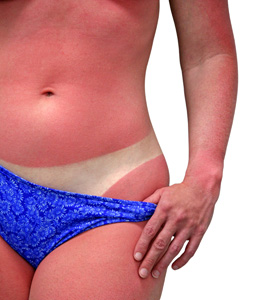Second Degree Sunburn
Dealing With Second Degree Sunburn
Getting a second degree sunburn is no fun at all. You may be in a situation where it cannot be avoided, but most of the time it can. The best way to deal with a second degree sunburn is of course prevention. Most of the time, when we have been out in the sun too long without adequate protection and get a sunburn, it is a first degree sunburn. We often become aware of the fact that we are getting sunburned in time to avoid getting anything worse that a first degree burn, which can be uncomfortable enough.
First, Second, And Third Degree Sunburn - A first degree sunburn is characterized by redness of the skin and pain. The pain of course may not be felt immediately, but will come soon enough. When water blisters or bubbles accompanied the redness and pain, you have a second degree sunburn. With a second degree sunburn some real damage has been inflicted upon the skin. It will heal, but the chances of scarring and infection are markedly increased. It is very important not to disturb the water bubbles. If they break, the area becomes very susceptible to infection. If the bubbles are more than a couple of inches across, become discolored, break open, or ooze liquid, medical attention should be sought. If the skin becomes white, it is a third degree sunburn and medical attention is definitely advisable.
Let's look into a few ways to prevent getting a second degree sunburn, or any sunburn for that matter, and then options available for treating a burn if you do get one. Obviously, application of a sunscreen or sun block is the next best thing to staying out of the sun altogether. In fact you can get a burn from sunlight reflecting off of water or the side of a building, and of course snow, even if you are in the shade. Sunburn on a cloudy day is less likely, but still can happen. Even if you have a dark complexion of a very deep tan, your can still get sunburned. Some believe that having a tan is the same as applying a sunscreen. It is, but only up to a point. A tan lessens the chance of getting a sunburn somewhat, but that can be a small somewhat. Also be aware of the fact that you don't have to soak up large amounts of sunshine to get your required allotment of vitamin D. Just a few minutes a day in light sunshine will take care of that. Or just drink fortified milk.
SPF, More Isn't Always Better - A sunscreen does not have to be industrial strength to help you avoid a burn. A lotion with a sun protection factor (SPF) of 20 will provide nearly the same protection as will one with an SPF of 40 or 45. If you use the higher number you'll still need to apply it as often as you would with a lotion having the lower number. A single application isn't going to give you all-day protection, no matter what the SPF. Sunscreen lotions aren't totally waterproof either; in fact perspiration can reduce their effectiveness relatively quickly.
If however, you've been having a great time of it, haven't taken the necessary precautions and at the end of the day find yourself the owner of a second degree sunburn, there are some home remedies you can apply to help your thorough the healing process. Of course if you are feeling at all ill, or as noted before, the blisters are very large, you should go to a doctor's office or clinic. An urgent care clinic, if there is one available, would be a good choice.
Home Remedies - Cool water will help, but avoid very cold water. If a large amount of your body has been burned, stepping into an icy cold shower could cause your body to go into shock. Cool water will feel better anyway. A shower is usually better than a bath, but if you choose the latter, adding a little vinegar to the bath water will help relieve the pain. In cases where the burn areas are localized, such as your face or neck, cold compresses can give relief. An oatmeal compress might be quickest to prepare. Another recommended home remedy is a potato compress, where a raw potato is cut into small pieces and liquefied in a blender, then applied to the second degree sunburn area as a compress. Aloe very is also good for a burn, adding needed moisture to it. Speaking of moisture, drink plenty of liquids, especially if a large area of your body has been burned. Drinking liquid helps your body deal with the trauma, and may keep you from developing a fever. One thing you don't want to do is to apply anything to the burned area with an oil base, such as butter or an over the counter oil-based ointment. This will keep the skin from breathing naturally and could lead to an infection. With a second degree sunburn you need to keep a close watch on the burned area to see that infection does not take place.
